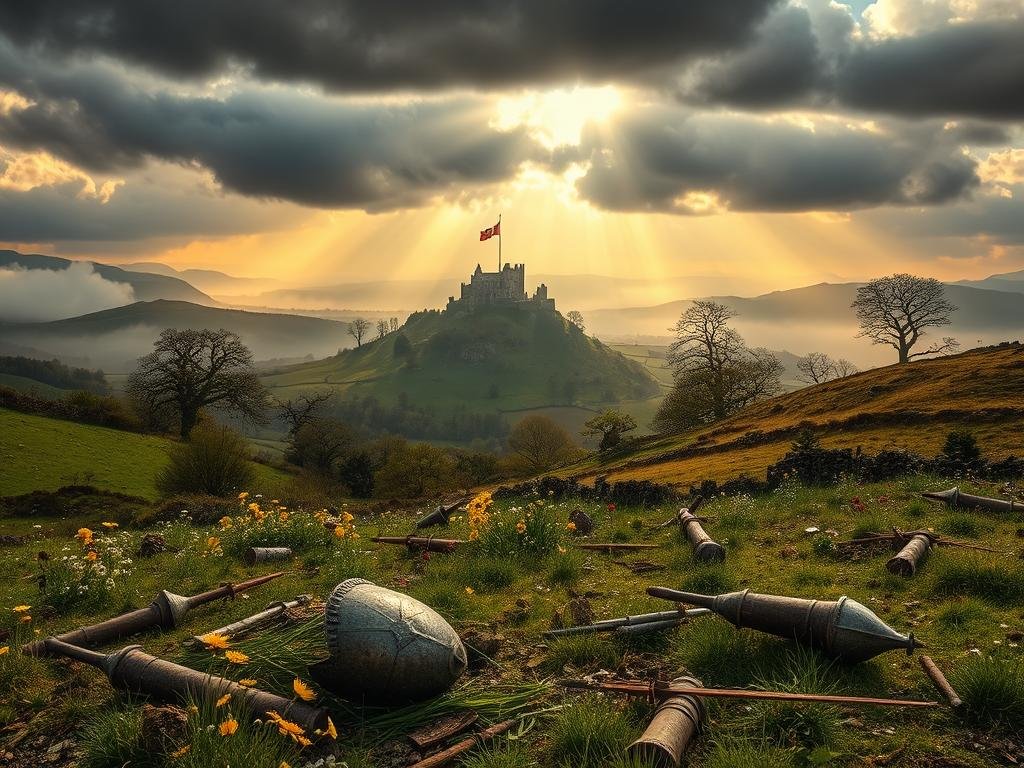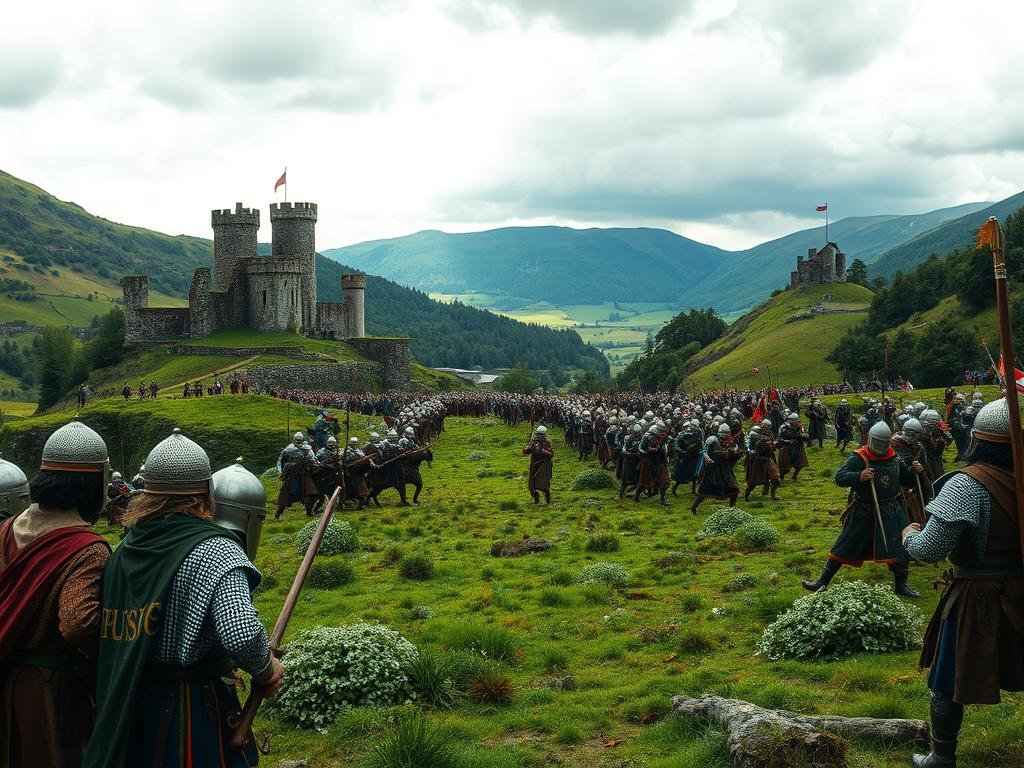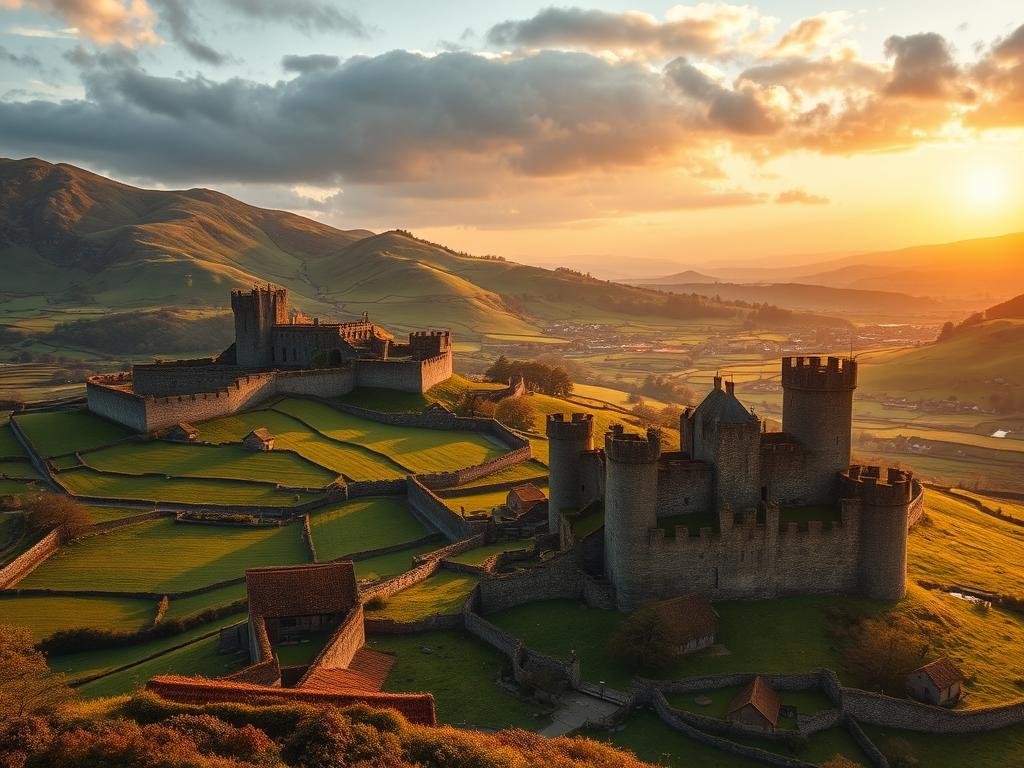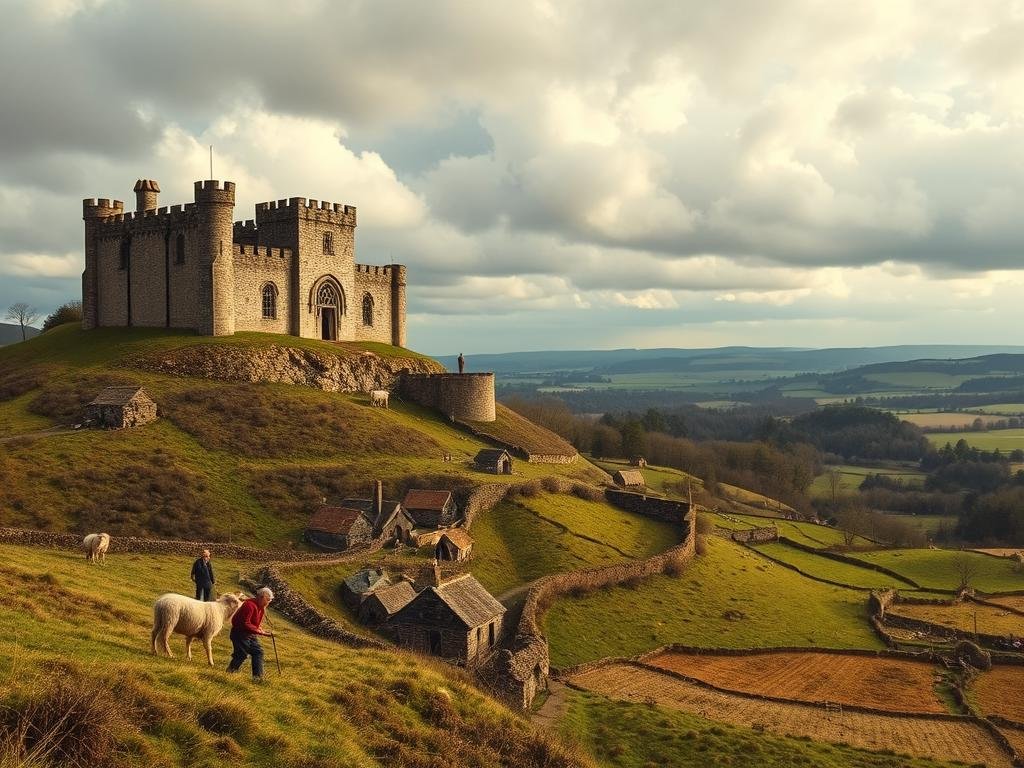Did you know that over 500 motte-and-bailey castles were built in England just two years after the Norman conquest? The Norman invasion of 1066 changed Welsh history forever. So what exactly was the Norman invasion effect on Wales?
The Battle of Hastings in 1066 was a key moment in British history. King Harold II died, and William the Conqueror took the English throne. This led to big changes in Wales, as the Normans expanded their territory.
The Normans brought the feudal system to Wales, changing its social and political structure. They built strong stone castles, showing their power. Welsh leaders like Rhys ap Gruffydd and Llywelyn the Great fought hard against the Normans.
The Norman Conquest and Its Impact on the British Isles
The Battle of Hastings in 1066 was not just a shift in kingship but a seismic change in the cultural and political structure of Britain.”
— Dr. Marc Morris, historian and author of “The Norman Conquest”
The year 1066 was a turning point in British history. The Norman conquest, led by William the Conqueror, changed England’s politics, society, and culture. The Battle of Hastings on 14 October 1066 led to King Harold II’s death and William’s victory.

William faced many threats and rebellions early on. He dealt with these harshly, like in the Harrying of the North. This was from 1069 to 1070, where he devastated land to crush Anglo-Saxon resistance.
The Norman rule in England took five years to establish, from 1066 to 1071.
The Anglo-Saxon Chronicle describes the impact of William’s harsh rule in the Harrying of the North as “a vast destruction that no history can entirely recount.”
William the Conqueror’s Ascension to the English Throne
“William’s land grants to his Norman followers were a calculated strategy to cement loyalty and power, radically altering the English aristocracy.”
— Professor Robert Bartlett, medieval historian
As the new King of England, William made big changes. He gave land to his Normans, replacing the Anglo-Saxon leaders. By the end of his rule, only two Anglo-Saxon landowners were left.
William also controlled the Church more tightly. He put Norman bishops in charge and moved dioceses to cities.
The Domesday Book records that by 1086, over 90% of English land was in the hands of the Norman elite, demonstrating the extent of William’s changes to the English landholding system.
The Establishment of Norman Rule in England
“The introduction of the feudal system by William was perhaps his most enduring legacy, reshaping both England and, subsequently, Wales.”
— Dr. Helen Nicholson, medieval studies professor
The Norman conquest brought the feudal system to England. William gave land for military service. The Domesday Book, made in 1086-7 CE, listed England’s land and wealth.
Trade with Europe grew, and English language was influenced by French. William’s rule in Wales was slow but effective. The Norman invasion started in 1081, and by 1094, most of Wales was under William’s son’s control.
This set the stage for more expansion and conflict in the future.
The Norman Expansion into Wales
expansion into Wales was marked by both military strength and strategic alliances with Welsh leaders, aiming to blend control with cooperation where possible.”
— Dr. David Walker, author of “Medieval Wales”
After the Norman Conquest of England in 1066, the Normans looked to Wales next. They wanted to expand their control and influence beyond England.

A new period of Medieval rebellions of Wales commenced. The Welsh were proud and resisted the Normans fiercely. Gwynedd in the north and Powys in the east were strong in their fight against the Normans.
The Normans, though, were powerful. They used military strength, built castles, and made smart alliances. They started to take over Welsh lands, like building Cardiff in 1081. There’s your first answer to the Norman Invasion effect on Wales…. our capital city!
The Welsh Resistance to Norman Incursions
resilience of Welsh leaders like Llywelyn the Great in opposing Norman advances shows a fierce commitment to preserving Welsh autonomy and culture.”
— Professor John Davies, Welsh historian
Despite the Normans’ progress, the Welsh kept fighting. In 1194, Prince Llewelyn Fawr united the Welsh and pushed the English out of north Wales in 1212. His capture of Shrewsbury in 1215 was a big win for the Welsh.
The Gradual Norman Infiltration of Welsh Territories
But, King Edward I of England changed things. He conquered Wales in 1272. His first invasion in 1277 brought a huge English army to north Wales. This led to Llewelyn Fawr agreeing to peace.
The Normans then built many grand castles in Wales. These included Flint, Rhuddlan, Conwy, Caernarfon, and Harlech. These castles showed the Normans’ power over Wales. if you haven’t visited any of these castles, I’d thoroughly recommend it.
The Welsh, though, never gave up. In 1282, Dafydd, Llewelyn Fawr’s brother, led a rebellion in northeast Wales. Though it failed, it showed the Welsh’ bravery against foreign rule.
The Establishment of Marcher Lordships
The Marcher Lords were a unique creation of the Norman conquest, blending English and Norman laws to manage the volatile Welsh borders.”
— Dr. Richard Huscroft, historian and author of “The Norman Conquest”
After the Norman Conquest in 1066, the Normans wanted to control more land, including Wales. They created Marcher Lordships along the Welsh border. This was a key move to rule over Welsh territories.
The Marcher Lords were strong Norman barons chosen by the English crown. They had a lot of power to run their Lordships and keep order in the border areas. They acted almost like their own rulers in the Welsh Marches.

The Role of Marcher Lords in Controlling the Welsh Borderlands
The Marcher Lords were key in controlling the Welsh borderlands and spreading Norman influence into Wales. They defended the Marches against Welsh attacks, kept the peace, and handled justice in their areas. They also brought in English and Flemish settlers to build towns and loyal communities.
The Marcher Lordships had their own laws, different from England and Wales. This Law of the March gave the lords a lot of power. It helped them govern their lands well and deal with Welsh resistance.
The Construction of Norman Castles in Wales
Norman castles served as both military bastions and symbols of dominance, embedding Norman authority in the very landscape of Wales.”
— Dr. Abigail Wheatley, specialist in medieval architecture
The Norman lords built many castles in Wales to strengthen their control. Castles like Chepstow, Pembroke, and Conwy were key for military, admin, and economic power. They were strong defences against Welsh attacks and showed Norman power over the land. If there’s one lasting memory of the norman invasion effect on Wales, it’s our beautiful castles.
Building castles in key places helped the Norman lords keep a strong hold on the Marches. These castles were bases for military actions, helping the lords fight Welsh princes and stop rebellions. They were also where the lords held court, collected taxes, and ruled over the locals.
The creation of Marcher Lordships and Norman castles changed medieval Wales a lot. The Welsh princes fought hard against the Normans, but the Normans slowly took over. This led to Wales being fully conquered by Edward I in the late 13th century.
The Norman Invasion Effect On Wales: Feudal System On Society
The feudal system imposed by the Normans was more than a landholding method; it was a cultural imposition, aiming to transform the social hierarchy of Wales.”
— Dr. Christopher Given-Wilson, medieval historian
This was a significant Norman Invasion effect on Wales. Welcome the feudal system, which changed how people lived and worked. Welsh lords had to serve Norman overlords in exchange for land and protection.
The old Welsh laws were replaced by Norman common law. The Welsh elite started to follow Norman customs to keep their power and status.
The Marcher Lordships along the Welsh border were set up in the late 11th century. These strong Norman lords controlled key areas like Chester and Hereford. By 1087, the Normans had taken over Gwent in the southeast.

William II’s reign saw more Norman attacks on southern Wales. Lordships like Cardigan and Pembroke were established. But, Welsh leaders like Gruffudd ap Cynan and Owain Gwynedd kept their kingdoms strong.
By the 12th century, Wales was independent again. This led to a cultural boom, with more Latin learning and writing.
The social changes in medieval Wales post-conquest were big. A new aristocracy of Norman and Welsh lords emerged. The feudal system helped create a class of landowners tied to rulers.
The Normans also changed the church in Wales. The old clas system was replaced by dioceses and parishes. This made Wales part of the European church.
Despite the Norman invasion, Welsh lords and Norman overlords worked together. They made deals like the one with Rhys ap Gruffudd. This showed the balance of power in Norman-Welsh diplomacy.
The impact of feudalism in Wales was complex. It was not just about being ruled. The Welsh adapted and kept their culture and identity alive.
The Influence of Norman Culture on Wales
“The linguistic and cultural influences of the Normans permeated Welsh society, leading to a fascinating blend of languages and traditions.”
— Dr. Sara Elin Roberts, medieval Welsh language and culture expert
The Norman conquest of Wales lasted over 200 years. It brought big changes to the Welsh culture. The Normans brought their language, customs, and building styles. These slowly mixed with Welsh traditions.
The Norman-French language changed Welsh a lot. French words like “barwn” (baron) and “gwarant” (warrant) were added to Welsh. This made Welsh richer in vocabulary. The Welsh upper class started using Norman-French, showing off their status.
The Adoption of Norman Architectural Styles in Welsh Buildings
The Normans changed Wales’ buildings too. They brought Romanesque and Gothic styles. These were used in churches, monasteries, and castles across Wales.
Welsh builders mixed Norman styles with their own. This created a new look that showed both cultures. It was a time of cultural blending.
Despite the changes, the Welsh people were strong. They kept some Norman ways but also held onto their own culture. Poets like Dafydd ap Gwilym showed Welsh spirit even after the conquest.
The Flemish Settlement in Wales
In the 12th century, Wales welcomed many Flemish settlers, mainly in Pembrokeshire. These skilled workers were brought by the Normans to strengthen their rule and boost the local economy. The arrival of Flemish settlers in Pembrokeshire was a big part of a wider migration across the British Isles. They also settled in Scotland, northern England, and Ireland.
The Flemish people first came to Wales as soldiers with the Normans in 1066. King Henry I gave land in Pembrokeshire to Wizo, a Flemish leader, who built a settlement around Wiston Castle in the early 12th century. The establishment of Flemish communities in Wales was marked by conflict, like the capture and destruction of Wiston Castle by Welsh leader Llywelyn in 1220.
The Norman invasion Effect On Wales: Impact on Local Culture and Economy
The Flemish settlement in Wales left a lasting mark on the local culture and economy. They brought their own culture and language, adding to Wales’ diversity. Over time, the Flemish language was replaced by English, earning the area the nickname ‘Little England beyond Wales’ or ‘Little Flanders’. Today, you can see Flemish influences in local place names in Pembrokeshire, like Wiston, Lammaston, and Rickeston.
The arrival of Flemish settlers had a big impact on the native Welsh people. The influx of Flemings led to the loss of the Welsh language south of the Landsker Line. This created a divide that lasts to this day. Castles were built along the Landsker Line, from Newgale to Amroth, as part of the Norman colonisation of Wales led by Flemish settlers.
Welsh Resistance and Adaptation to Norman Rule
The Welsh displayed remarkable resilience, not only resisting Norman incursions but also assimilating and adapting elements of Norman culture to suit their needs.”
— Dr. John Gillingham, historian
After the Norman Invasion of Wales from 1067-1266, the Welsh showed great strength. They resisted and adapted to the Norman rule, creating a unique identity. This identity mixed Welsh and Norman cultures.
The rise of Welsh princes like Llywelyn ap Iorwerth (Llywelyn the Great) and Llywelyn ap Gruffydd (Llywelyn the Last) was key. They fought against Norman rule, forming alliances with other Welsh and English nobles. Llywelyn ap Iorwerth, who ruled from 1200 to 1240, built strong stone castles like Dolwyddelan and Dolbadarn to protect his kingdom.
The Gradual Assimilation of Norman and Welsh Cultures
The ultimate Norman invasion of Wales effect was gradual (think of a frog in boiling water – put it in and gradually increase the heat, it doesn’t notice the change until it’s too late and it’s boiled). As the fight against Norman rule went on, Norman and Welsh cultures started to blend. Norman and Welsh families began to marry, mixing traditions and customs. This change is seen in Welsh literature, like the First Branch of the Mabinogi and poems from the Book of Taliesin.
The Treaty of Montgomery in 1267 was a big step. It made Llywelyn ap Gruffydd the Prince of Wales, recognised by Henry III. This treaty, along with the blending of cultures, helped create a strong Welsh identity that lasts today.
Key Takeaways
- The Norman conquest of 1066 had significant ripple effects on Wales, leading to the expansion of Norman control and influence.
- The construction of numerous motte-and-bailey castles and later stone keep castles served as symbols of Norman power.
- The introduction of the feudal system in Wales altered the social and political landscape of the region.
- Welsh leaders such as Rhys ap Gruffydd and Llywelyn the Great led resistance efforts against Norman incursions.
- The arrival of Flemish settlers in Pembrokeshire further impacted local culture and society in Wales.
Conclusion
The Norman invasion effect on Wales had a giant impact on Welsh history. It left a lasting legacy that shaped Wales. After the Battle of Hastings in 1066, the Normans started to move into Wales. They faced strong resistance from Welsh princes.
Despite the challenges, the Normans slowly took over Welsh lands. They built strong castles and created Marcher Lordships. This showed their control over the border areas.
The legacy of the Norman invasion shows Wales’ strength and ability to adapt. It’s a story of resilience and change.
Matt






